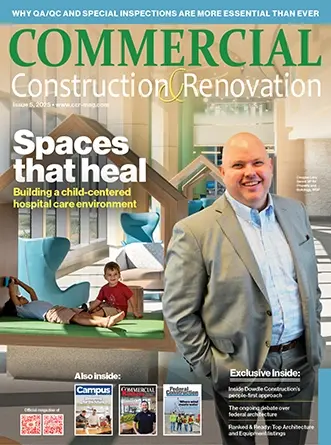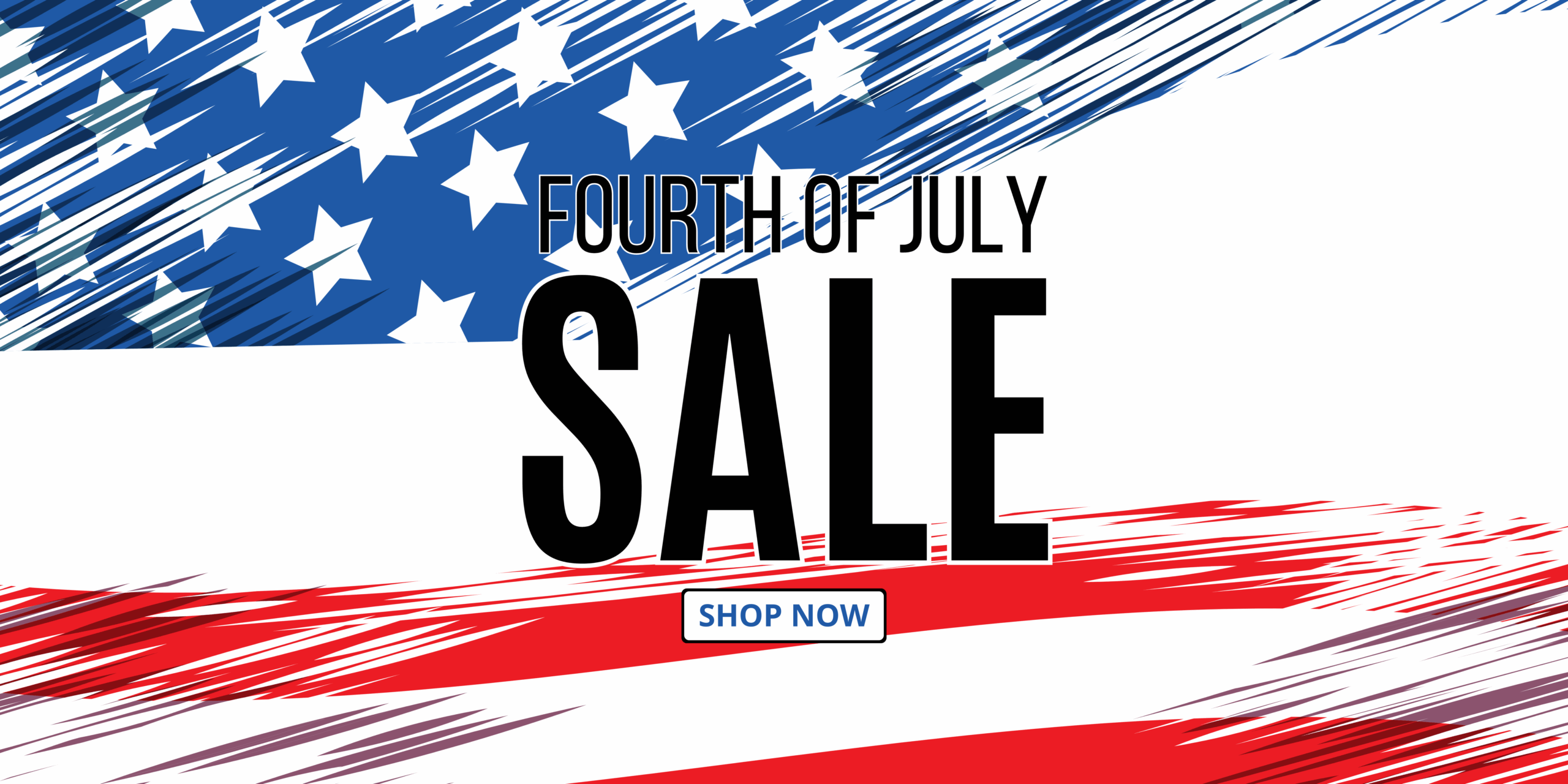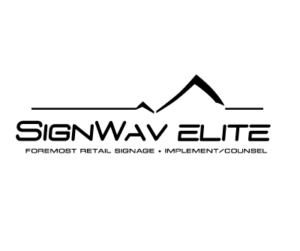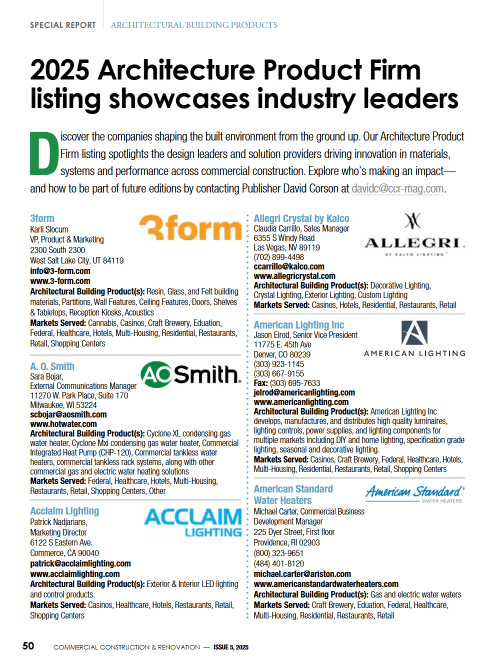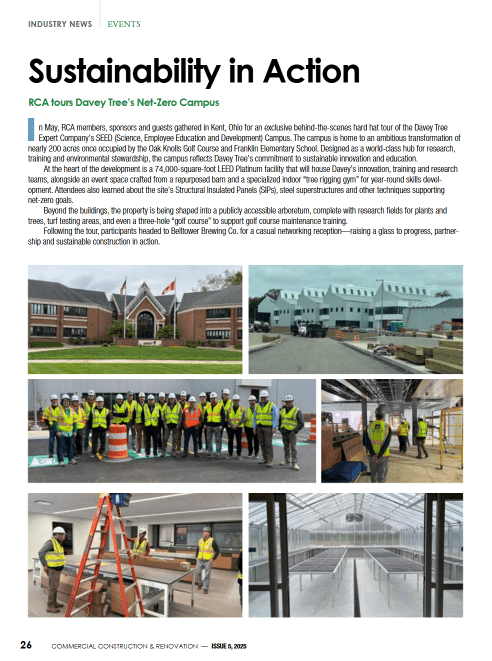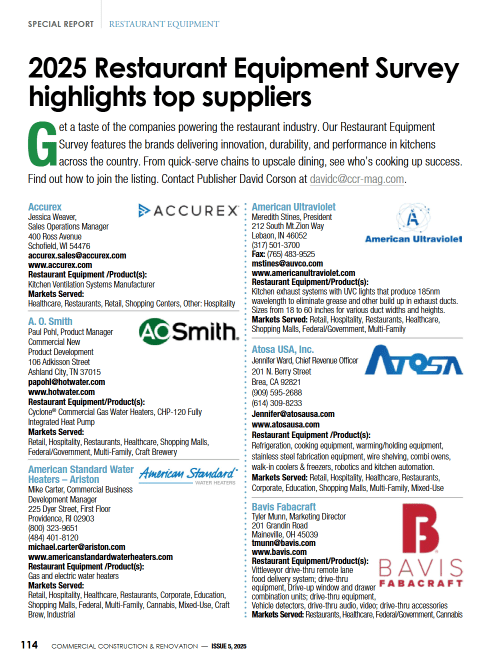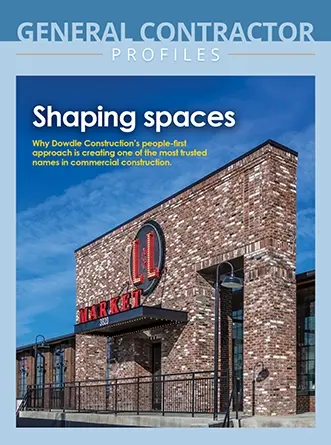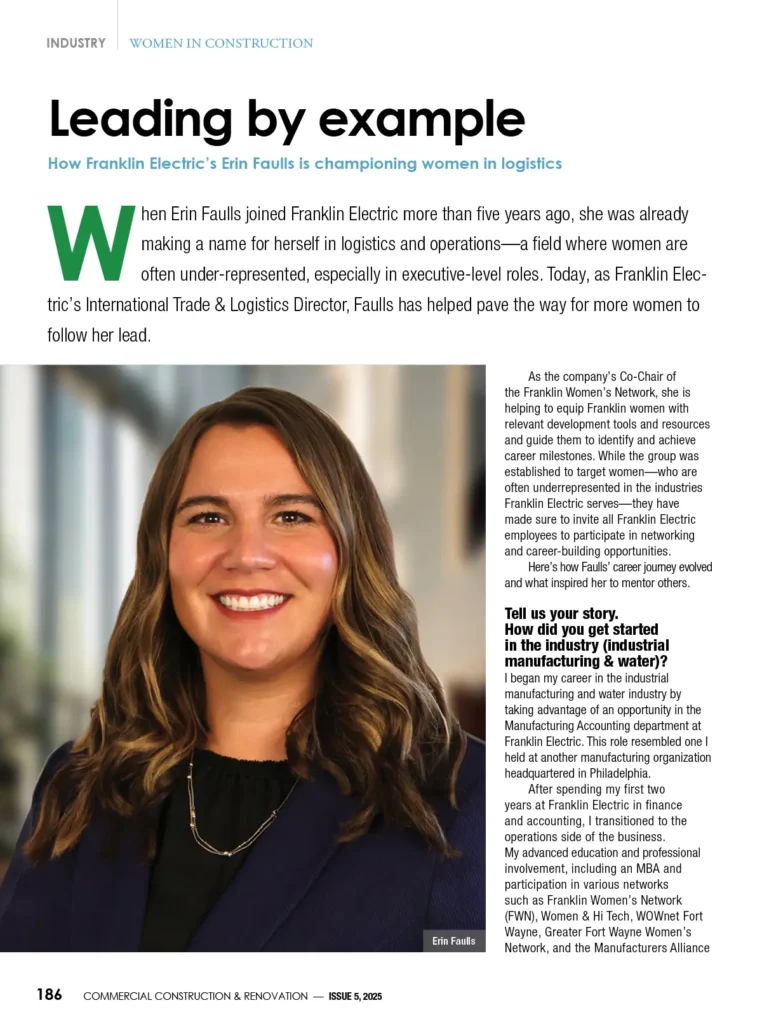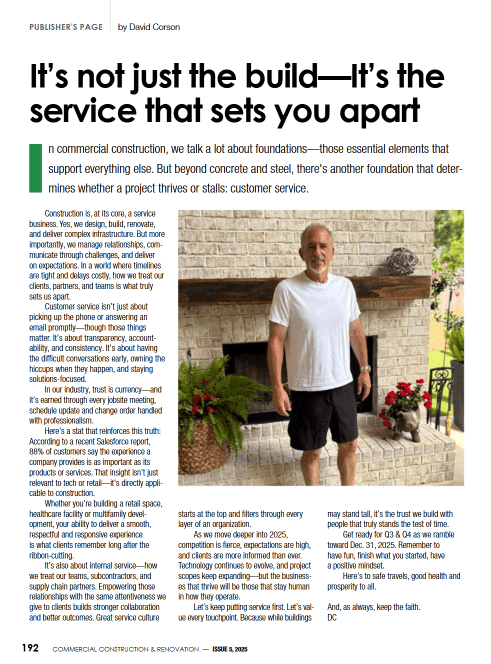CCCT with Ben Meyer, Building Enclosure Business Director at Siplast Video
CCCT sat down with with Ben Meyer, Building Enclosure Business Director at Siplast, that extends their expertise and services from roofing and waterproofing to vertical commercial walls to provide compatible solutions for the many necessary complex transitions from roof systems, waterproofing systems, openings, and penetrations to create a continuous air and water barrier for commercial buildings. Improving enclosure airtightness and moisture management: Improves moisture protection to meet durable and resilient building design requirements. Enhances energy-efficiency and reduce carbon from the building operations to meet sustainability goals. Enables improved occupant health via indoor air quality, thermal comfort, and material choices as part of wholistic design solutions. Siplast is a member of the Air Barrier Association of America (ABAA). Enjoy the conversation.
1. The YouTube episode features Ben Meyer, the Building Enclosure Business Director at Siplast, interviewed by David Corson, the host and publisher of Commercial Construction and Renovation magazine.
2. Ben Meyer is from Virginia and discusses his background, including his experience working with the Department of Energy.
3. The conversation touches on lessons learned in the past three years, particularly in the architectural field, with an emphasis on understanding different construction products and their applications.
4. Ben Meyer highlights an energy report he worked on, focusing on improving energy efficiency in buildings. He mentions a Department of Energy initiative called Renew Amer that provides grants to school districts for energy-related improvements.
5. The discussion also covers the impact of technology, such as Zoom, on the construction industry, emphasizing its efficiency and effectiveness, and encouraging engagement with digital tools for communication and project management.
Transcript Hey there, Commercial Construction Coffee Talk fans, thanks for chiming in. My name’s David Corson, I’m your host. I’m also the publisher and editor of Commercial Construction and Renovation Magazine. This is what it used to look like; we’re digital now. August of 2021 was the last issue that I printed when I had White Castle on the cover. This is, let me see, April 22. I’ve got Miss Julie Cinski, Director of Construction Design and Entitlements at Floor and Decor. Thanks, Julie. You’re local here in the ATL. Thanks for building that Floor and Decor up and coming. That was a great renovation of the Engle shopping market up there. I watched it all get done. It’s a pleasure having you on the cover. This issue was 144 pages. I always like to see where I was doing something. I was water skiing up on the lake. It’s beautiful out here today in the ATL, and I can put a wetsuit on and go do some skiing here late this afternoon before the weekend comes in. In my younger days, I used to ski all the way to December with a full wetsuit, then it was about two months off the lake. But then, of course, I had kids. But now we’re back. I have a piece of land I’m building up on the lake. That was my skiing picture, so it was always good to see what’s going on. You know what, I love holding the magazine, but I’m digital now. I don’t miss the printer, I don’t miss the post office, and I don’t miss any of those guys. It’s been an amazing ride on the web. Just had another couple million people hit the website last month. I don’t know where I’ll end up. We had 29 million people last year hit the site. It’s just been unbelievable making the transformation from print face to digital. I couldn’t have done it without all of you out there, so thank you so much if you’re in here listening to our episode today. Today, I have a gentleman up in the great state of Virginia out of Richmond. His name is Ben Meyer, and he’s with Siplast. He is the Building Enclosure Business Director. Did I get that right? Nailed it, yeah, yay, awesome. The reason I had Ben on, he actually works with the Department of Energy, and he’s got a report that he wants to talk about. So Ben, say hello to our listeners out there on Commercial Construction Coffee Talk. Hello, thanks for having me on. This is great. What’s the weather like in Virginia? Is it pleasant? We’ve had an extended fall, which I appreciate. The winter is staying away for now. My trees out front, you know, they’re still kind of red, but the leaves, all of a sudden, we have had a nice wind coming in. I told my wife, look, the leaves are going to be all over the place. We were raking them last weekend. I said, they’re not having a problem. What we need is one good little storm to come through here, and sure enough, they’re bare but they’re blowing all over the place. It doesn’t happen slowly; it happens all at once. Everybody’s got their bags out in front of their houses, and you know, put them in the reusable bags. But it’s beautiful today in the ATL. Listen, we appreciate everybody chiming in, listening to the episode. Ben, the way this is going to work is we do our interviews in three parts. You’ll tell your story, where you grew up, where you went to school, and how you ended up where you are today. Then we’ll talk about the last three years in your report, any lessons learned that our listeners out there might find of interest, and then you’ll leave one positive thought or phrase and your contact info, and then we’ll close it out. So, with that said, the floor is yours. Tell us your story. Starting from scratch, I’m from Cincinnati, Ohio, originally. I’m a transplant to the Virginia area. I grew up in the Indiana, Kentucky, Ohio region. I was born in Kentucky, grew up in Indiana, and lived in Ohio the second half of my school career, just kind of working my way around that corner. I lived there up until about 12 years ago. Really, and I think this is what kind of rounds it out to the other side of this, all the way up into the recession. That’s when things got weird, and we had to start looking around for other opportunities. I think that story has replayed itself but in a much more compressed fashion in the last few years. It’s very circular, and the cycles have gotten shorter. That’s really led me to Virginia. Along the way, in college, I started in architecture. I’m an architect by trade. Where did you go to school? University of Cincinnati. Oh, Bearcats, yay. That’s right. I always tell people they keep one in the zoo just across the street to point to. It’s not made up; it’s real. Just across, you have to go look at one because the mascot is an odd creature. The University of Cincinnati for architecture. I spent a lot of time with them there. Along the way, in my architecture experience, one part I love about the University of Cincinnati is that it’s a co-op program. After your second year, you’re doing design in the classroom, but then every other quarter, you go out and work for a firm. They pay you, and you have to do real work, and you get feedback on the job you’re working towards, rather than waiting six years to find out if you like this or not. You get that feedback very early on. It’s fantastic, and it gives you context as you’re doing your design work. It’s very easy, especially as you get into graduate school, to focus on the concept and not what it takes to make a building in real life. Those can be very divorced. Experiencing both sides of that through school was incredible. One of my takeaways was that architecture is really a business, and the education of architecture is about art and design, and there was a gap. If I’m going to be successful in architecture, I really have to learn the business side of it too. I can be good at design, but I could run a company into the ground because I don’t understand the business parts of it. So, in parallel with my architecture education, I got into business as well. I did a business minor in my undergraduate and then an MBA as I was doing graduate architecture, just because it felt like I needed that balance. I needed that context because, in the end, especially pre-recession, most architecture firms were small practices, five, ten, maybe twenty people doing most of the work, and there were a few medium and large offices. I think in the last 10-15 years, that’s transitioned a bit. There are a lot more larger firms and fewer independent practitioners, but I think there’s still a large number of those. Well, you know, in architecture, about 20% of the firms do 80% of the business, and then there are thousands, millions of small firms out there, doing a couple of projects. We do an architecture ranking during the year. I had an architect on the other day, and he said the same thing. He went to architect school, did his MBA at USC, and went to Washington University in St. Louis for his undergrad. He said when you go to school to be an architect, they don’t teach you about arts and design; it’s about being a project manager. You’ve got the architect, the developer, all these guys tied to the hip, and it’s not just Arty farty and using CAD and BIM and all that stuff, it’s a business whether you are the owner or not. You really are almost like a project manager because you’re there until the completion, until they turn the keys over to whoever the end user or owner is. I thought that was really interesting. They don’t teach that in school. I’ve been taking digital classes for the last year. I thought I knew a lot about digital, but I didn’t. You can teach an old dog new tricks. There’s so much to learn. I’m in this influencer group, about 250 people in these classes. Some of these people are looking at IATA and they’re like, “What is IATA?” That’s your number that you want to be as positive as possible. But just little things like that, like how do you open up a bank account? Why do I need an EIN number? What are the tax implications? Why do you need a CPA? Because there are regulations out there, and the taxman wants their money, and you don’t want them knocking at your door. The bottom line is you go to school and then they throw you out into the real business world, and you’re like, “Wow, this is not what they kind of missed.” They really should teach people in high school how to balance a checkbook, how to run something on a budget. By the way, I lived in Cincinnati. My parents are from there. My mom’s remarried, but that was past. He was in Dayton, Ohio, and I lived in Cincy for about two years. I lived at Fourth and Plum. There was a building I had, before the new stadium was built, probably in the early ’90s. I had the view of the river. I could watch the fireworks go off when someone hit a home run at the stadium. There was this building called SNL Data, an old parking garage that got renovated. I had no walls in my apartment; it was like a big open studio. I watched this office building get built in front of me. When my view left, I got transferred. I went to Louisville. That’s my story about Cincinnati. I have very fond memories of it. It was during the strike when Ickey Woods was doing the shuffle, and the scabs were out there trying to keep the NFL going. That’s when I was there. Oh, Mount Adam and Skyline Chili. Cincinnati was a great town. When I first moved there, I lived across in Covington. I didn’t know where I was going to live, so I lived across the river. Then I moved across into downtown Cincy, and then I made my transportation. Cincinnati, Kentucky, Indiana, you’re right, it’s like one big metro area. My caveat is now that I’ve moved to Virginia, it’s great when the sun’s shining and it’s warm out, which narrows down the number of days. There’s a lot of cloudy, rainy days in Cincinnati. That’s what I learned moving away. I didn’t appreciate how much rain there really was, and there are orange barrels on the highway all the time. I drove up from my sister’s 60th birthday a couple of years ago during the shutdown. Coming in through Kentucky, the orange barrels, I’ve seen these for the last 25 years. They just move around. That’s my Cincinnati story. Let’s talk about March of 2020, the roller coaster starts for everybody in the world. Prior to that, cranes everywhere, building construction, low unemployment, no issues with labor inflation, and then everything comes to a standstill. Here we are, three and a half years later, still talking about it. People found out more about their business, that there’s more to life than just work. They became more profitable, more efficient. Some companies have had some of the best years. I just turned 60. I went through the oil embargo in the 70s, the recession, the internet.com crash, the housing market crash, and then this pandemic. I was kind of forced into becoming a digital guy. All along the way, I’ve learned so much. I’d like to know what you’ve learned and seen out there from the architectural side of things, and then we want to talk about your energy report. I’ll tie this into my transition from working in architecture primarily to the manufacturing side, which happened essentially in the recession in 2008. Things were moving along well; we had projects on the board. I was working for a developer doing design work, project management, and owner’s representation. We would design, then build. We would finance our own projects. Suddenly, projects in the future wouldn’t get financed. We were closing out others, but the new ones weren’t breaking loose. You start looking around, saying, “Well, this isn’t quite going the way I think it’s going to go.” That led me to transition into manufacturing, working as an owner’s rep and general contracting for a manufacturer. I built factories in the 2010-2011 timeframe, then got into supporting the business side of it, re-engaging with the design community to help specify products. What you learn quickly in design is everybody needs to understand all the products, but they don’t necessarily understand the differentiation between them. When do you use this one, when do you use the other? I got into that as a result of that shift in the recession. The roller coaster happened much quicker, a much tighter timeframe, like a Millennium Force roller coaster. I was working for a manufacturer, one of our sister companies, primarily supporting the design community, doing education, helping them with specifying and consultative selling. I wasn’t really selling; more the consultative side to help them understand what products they need. We had this whole program around doing workshops and traveling around to folks, bringing them together. The core of what we did was educating and interacting face-to-face all over the country. On February 22nd, I flew back from my last event in Fort Lauderdale. I had another one in two weeks in the Seattle area, one of the first outbreaks at the time. Nursing homes were in Seattle, and we were like, “I don’t know if that’s a good idea. I think we might need to put a pause on this one.” Initially, it was like, well, give it a couple of weeks, we’ll see where we go. I was in a team with about three or four other folks, doing the same thing, supporting all over the country. We gave it maybe three, four, five weeks, and we were like, well, we can’t sit on our hands. Our job is to talk to people. How are we going to do this? It wasn’t an order that came down from high above that said, “Hey, you guys need to transition into digital.” It was more a matter of, what is our core function? We were already a remote team. We would get together on site to give these events wherever they were hosted at. We already had the remote thing figured out. It was more a matter of how do we interact remotely with other people? Within a few weeks, honestly, because we had so much education content that we were doing in person, we just had to transition that to virtual. For that year, we put on probably 20 or 30 workshops. We would do a weekly event, and I think we issued, with the four of us, almost 10,000 CEU credit hours. It was more a matter of just transitioning quickly into how can we deliver the thing we want to do in a different mode. Luckily for us, we had a captive audience. All of our customers were also sitting at home, like, what the hell? They were all sitting at home, watching Netflix or the Ozarks or whatever. I remember, in January 2020, my 10th anniversary event had the most people I’d ever had come to my summit. It was a great event. I was doing cocktail parties once a month to get local subscribers together, we promoted the magazine. I was in Fort Lauderdale, did a tour of a shopping center in Coconut Grove that was getting renovated. Then I was up in Milwaukee the second week in March, looking at hotels for my executive retreats in the fall. Tom Hanks got the bug, and everything got cancelled. I was supposed to fly to Columbus, Ohio, to watch the Buckeyes play University of Denver. I was a lacrosse player. Everything got cancelled, March Madness, everything. But like you, I was already working out of my house. I had a digital magazine that I kind of ignored. I didn’t even really know how much content I had on there. All of a sudden, I was like, oh my God, I have like 25, 30 thousand pages of stuff. I was blogging from way back when, before blogging was even a word. From a print guy, I was like, oh my God, can I do this thing digitally? I liked having the magazine and looking at it. Are people going to… so I had a lot of, I was fighting with my printer. I said to him, “Do you want me to put this March/April issue out, and half the offices are closed? People are furloughed; they’re all going to go in the trash. I don’t even know if people are going to see it.” He said, “Go, Dave, you’ve been a publisher forever. Economics to scale, once you set up the press, it’s minimal.” I wanted to do a small press run for people that I know. He said, “Uh, so…” I bit the bullet. It was my wrap-up issue for my events, so I said, “Okay, I’ll throw it out.” Then, the month of April, I kind of sat back and thought, okay, this thing’s going to go on longer than it’s going to. We have to make a decision. My editor, my artist, like, we have so much content, let’s just go digital. Yeah, we do a small press one for the advertisers or people that were featured in there. And I said, “Okay.” Then we, and like this podcast, I just bought my mic. I was going to go out and interview people on the construction site on my travels and do these shows. Then all of a sudden, I said, “Okay, I’ll just start doing one a week.” Now, I’m up to 170 episodes, I don’t know what it is. I was awful in the beginning; people laughed at me. I didn’t care; you just got to take action, make mistakes. I’m still not that good, alright, but I have fun, and I’m smiling. We did the virtual events, tried Family Feud, Hollywood Squares, all these different things to get people together. Little by little, the country started to open up. This year was my first year really back on the road, walking events, trying to see who was where, who’s retired, and who, you know. It was good to see people, but I don’t miss traveling. I’m a million miles on Delta. I don’t miss getting on a plane; I don’t care if I get on another plane. I’ve got my bracelet; I don’t care. It doesn’t matter to me, but I miss seeing my peeps. Next week is my last event in Scottsdale. I won’t see anybody until probably February when we pick up in the year. That was the biggest thing, but like you, I was already kind of set up. So, the people that didn’t turn on a dime, that had to get everything set up, I think they were the ones that were behind. A lot of the people, like yourselves, were already used to, like all the contractors that I know, they were first-line responders. They put the mask on; if their project was deemed essential, they had to go and do it. They got in the car, got in the plane, went out there, put their mask on, and just dealt with it. I give all those guys credit that were troopers out there, like yourself. Once again, if the offices weren’t open, what are you going to do? You got this platform sitting here. Zoom was it; now you got Teams and Google, but I’m a Zoom guy. But the biggest thing is, I remember having a conversation with a project manager firm. He said, “Listen, in one day, I was in Saudi Arabia, South America, Europe, Central America, Canada, and I did two walkthroughs in the United States.” Before the roller coaster started, that would have taken me three weeks, airfare, hotels, food. I can do all that in one day now. I can pick and choose where I want to go. If there’s a punch list item, like a roof curb that needs to be fixed, I can just do FaceTime with the guy, versus me, you know, or it’s an hour and a half in traffic. Just do it on, you know, you know where I’m coming from. What we found, even interacting with designers, helping support them, it would always start with a CEU or some kind of formal event. Then we would talk, usually after an event, if somebody had something relevant, and then it’d be a follow-up meeting to see the drawings, maybe see the spec. With this new format, we would do an event, put up a calendar invite, folks could schedule meetings, and then within a day, they would be sharing their screen and designing in real time with us. The distance we had to navigate from interaction to execution collapsed immediately. That’s one of the things that should have happened a long time ago. We just didn’t have the overall understanding or commitment to try to do it digitally. It’s not going away. People tell me, “Oh, I’ve done so many Zoom calls, I’m burnt out.” It’s not going away; it’s just so much easier. I tell people, “Look, this right here, the cellphone, is your best thing you can have. You can reach the 8 billion people on the planet, anywhere on the planet. Your contacts are in there; you can do Zoom, CRM, everything you want to do is right here in the palm of your hand. It’s an amazing tool.” I tell people, “You should make five to ten calls a day, if you’re going to make calls, just to talk to people on the phone, or if you want to do them on Zoom, that’s fine, but just make the call.” It’s an amazing tool, but people are not going to get rid of this. The pendulum swings back and forth, but this is not going anywhere because people realize they can just get as much done. There are events or projects where you have to go out and fix something or take a look, so it’s a tool. In your tool, as a contractor, you have your hammer, wrench, wire clippers, and now you have your Zoom too. It’s going to help. We had many project follow-ups from educations where the designer would say, “Hey, I have this,” and he would invite his general contractor, and he would pull on site. So, we’re all on the screen together, looking at the same thing and marking it up in real time. To coordinate that site visit would have taken weeks, and we would have moved on with construction and never would actually have had the conversation we wanted to have. But the people that weren’t set up, that was the biggest thing. Okay, I have to buy laptops for all the people. Some people aren’t built to work out of their home. You might have dogs, kids; everybody was different. Myself, I had been doing it for so long that it didn’t even bother me. It was a learning experience still because there were so many people that, if you didn’t have a cell phone, having a cell phone, or if they had a Gmail account and because they weren’t at the office, that was probably the most golden thing you could have, in my opinion, into making it through to the opening up of other counties. Zoom is just an amazing tool; it’s not going to be going anywhere, and it’s been a Godsend for myself and everybody else, including yourself. Let’s talk about your energy report that you did. Give me the basics. To get from Zoom to there, one of the things, you know, I work for a company that’s part of Standard Industries. One of the things they did well was, again, we were all well-positioned to go into this remote work, but we also started seeing over the horizon to say, “Alright, what’s the next step? How do we go from this to the next opportunity?” And that’s kind of how I got into my current role, really focusing on doing less general design support and actually getting into CPL, trying to expand their business offering. CPL is known for their roofing, waterproofing, being a consultant and specifier-driven premium solution for roofing and waterproofing. One of the opportunities we started to explore was expanding that into the wall space because our consultants or designers were designing both of those things, the roof and the wall. We just hadn’t as a general business been participating in wall applications. So that’s where I, you know, coming out of the pandemic, we’re still partially remote, starting to move around. I started this business opportunity inside of CPL to expand that premium consultant-driven roofing, waterproofing to above-grade air and water barriers, insulation. So that’s what I’ve been doing for the last almost three years now. Again, early transition into, say, well, how do we come out of this? Where do we want to be? Who do we want to be when we grow up, and people start going back to work? So we started on that early to get our R&D folks busy but also having where do we want to go, rather than just, “Hey, we’re worried about supply and pricing.” Because that’s where people were at the time. “We’re missing this ingredient; we need to qualify another.” And that’s not really R&D. And that was part of the challenge, is, well, how do you, what is the next innovation? Kind of stepping back and then driving it forward. So that’s what we’ve been doing for the past few years, really taking the experience that I have. I’m one of the board of directors for the Air Barrier Association. I’ve been on there for almost 11 years now. I’m part of the ASHRAE 90.1 envelope committee, and I’m currently the chair of the envelope committee for ASHRAE 90.1. So, I’ve been doing that when I say wall-focused work in the background while supporting roofing, waterproofing. Being able to bring that to the forefront and help expand our business that way has really been what we’ve been driving towards. And so, your question around the Renew America School Grant, this is something that we’re pursuing, and it kind of intersects with what we do in multiple ways. It’s really focused on existing buildings, taking schools that are in need, not just older and in need of renovation, but also in communities that may not have the funds to rebuild or do retrofits. The Department of Energy, as part of the infrastructure bill that was passed (I think it was in the first wave), that’s $500 million they set aside for the Department of Energy and education facilities. This first wave of the Renew America School Grant ended up around $150 million. Schools had to put together proposals around what energy improvements they’re looking to make and how that will impact their facilities and what they will do. They ended up accepting around 30 school districts across the country based on need, based on their proposals. There are other rounds that will come out, but the goal is to spend that money by 2026. So there’s a lot of money going in that direction to improve facilities, to improve the energy efficiency of these buildings. And a lot of that serves the community for the next 40 years because when they do the improvement now, they’re not fighting that uphill battle about energy use consumption; their costs go down. It’s kind of the adage about when to plant a tree; the best time to plant a tree was 10 years ago and right now. So they’re in the boat where they can do it right now. They accepted air barriers. People don’t understand it’s like having a little area where air can get in; you don’t know how much that can cost you in your electric bill. Making sure your seals on your windows are good, it’s basically general maintenance on any whether it’s your house or a school or an office building. If you do good maintenance, you can definitely cut down your energy usage or energy loss, letting heat or cold air come into your facility. You got to be conscious of it. People don’t realize that little hole can cost you. It’s like letting your sink drip, and it keeps dripping, and then you get your water bill, and you’re like, “Why’s my water bill so high?” But you let it drip all night; you could have a couple of gallons of water. Now it doesn’t sound like much, but if you’re in a school and you know all the sinks, all the toilets, I’m just using general examples, but you know, with air and being insulated, homes that are well insulated, I was in my when I drove up from my stepdad passed away a couple of years back. I drove up and helped my mom get the house together. Anyway, there was a big storm that rolled through and started in Cleveland and went right down I-71 all the way into Northern Kentucky. I was in there in June. Anyway, all power got knocked out, so my mom’s house, she was in Springfield between Dayton and Cincinnati off of I-75. Anyway, the house was probably only a couple of years old but was built really well. So during the day, it was like 100 degrees outside with humidity in June, typical Ohio weather. I went to Starbucks because there was no electricity at the house, but I had to run my business. So I’m sitting in Starbucks all day, but at night, we shut all the shades, try to do all that stuff. But at night, we sat there in the dark, and we listened to the damn radio, which brought back memories of when I was growing up way back when. But I told my mother, “It’s not even really hot in this house.” And she goes, “Oh yeah, the builder did a great job, you know, insulated, we did the foam, we did this and that,” and it made such a difference. An older home without electricity would be hot, but I was shocked at how cool the house was. It was actually cooler than during the night after the sun went down. Especially when you control air leakage, there’s a three-fold effect, especially if it’s an older building. The first one is comfort. It’s going to be more comfortable, especially in schools where they may turn off the AC in the summertime for special events or things like that. In August, or when you come back to school, it can be very hot, so you’ll get a lot more comfort. The other one is energy efficiency, obviously, that you’re going to save money and it’s more resilient in those cases that you can have periods where the systems aren’t coming on constantly every time the clouds come out. And the third one, which used to be kind of the nice to have, is indoor air quality. That transition was the whole point, like that’s the reason we have this funding bill. It’s around indoor air quality. When you do air tightness improvement, you also want to do HVAC improvements because you’re doing ventilation, you want to control that. If you want to add filtration systems to your school for disease control, all those things, you have to do that in conjunction with air tightness. If you haven’t controlled that enclosure, if the doors are just open, you’re filtering the outside air, you’re not actually solving the problem that you look to solve. So those air tightness and HVAC improvements are like peanut butter and jelly. If you’re going to do one, you really need to do the other. We have a lake lot and we’re about ready to break ground. My wife’s a federal contractor, and we do small jobs. We’re going to build ourselves, and one of the things I told her is I want to have this house insulated tight. I want it tight. I don’t want anything getting out. So I’ve been talking to some vendors. I’m working with a lot of my vendors; we’re going to do videography of the build over a 12-month period and probably feature it in the magazine. But I said, look, I’m going to be up there when they do the insulation because that is like the most important thing, whether it’s in the winter or in the summer. You want your house to be like a lockbox. It’s a combination of the insulation and the air barrier. They all need to work together. One of the myths, but it’s a reality, is this idea of a sick building. If I make my building too tight, I’m going to get sick. Well, that’s where ventilation comes in. That’s what we didn’t do in the 70s when we discovered this. We tightened up buildings and didn’t change any air. There were no exhaust fans in your bathrooms, no air supply. So if you’re exhausting air, you need to add air back in, filter it, do all those things. That’s the modern equivalent. In order to do a good HVAC design, be energy efficient, you need to build tight, and you also have to ventilate it. That’s a myth that’s really hard to dispel. If you build it too tightly, it might be a sick building. If you ventilate it and design it for humans to occupy, that’s not a problem. But if you don’t build it tightly, you’re just throwing energy out because you’re afraid. You might as well spend the money and get it fixed than just spend money and waste it. Where would someone find your energy report? It’s run by the Department of Energy. It’s called the Renew America School Grant. There’s a lot of information if you go to energy.gov. Those are schools that need the improvement and will benefit from that improvement for years. If you’re not a grant recipient, does that mean you throw your hands up and say that’s it for me? No, there’s a lot more money still in that infrastructure plan. From a practical point of view, anyone can run this process. ASHRAE publishes a procedure for commercial energy audits. Whether it’s a school, a hospital, an office building, you can essentially run through the same process and build your own scope. There are a lot of other grants available or money coming in from the federal government from this infrastructure bill. Running that commercial energy audit will help you identify the impact. Are you getting the return for that money spent? Is the money best spent in PV, HVAC, roof insulation? That process will help you identify what the right order of events should be to get the most bang for your buck, whether it’s energy, comfort, or indoor environmental quality where it’s filtration. The federal government has a lot of money. We’re all paying into it. Even if you don’t get the grant, there’s probably some money there. You just have to navigate your way and find the right administrator to point you in the right direction. The most important thing is to do the audit to find out what you really need, and then go find the money. It’s not, “I can’t do it,” it’s, “How am I going to do it?” If you’re in the new construction world and you’re looking to design to the most current efficient standards, ASHRAE 90.1 just published a 2022 version. It’s cost-effective today. By following that, you can get cost-effective, energy-efficient designs. Also, you can use that as a tool. If you’re looking to future-proof your design, a big part of that is when you do the renovation. Design with the retrofit in mind. It’s easy to save a dollar now by designing a building in a way that doesn’t allow you to replace the roof without tearing the wall off, which we do all the time in construction to save a few dollars. But in 15, 20, 30 years, when the roof needs to be replaced, you may have to remove parts of the wall, which is an unnecessary cost and hassle. Brick on the whole building to replace the roof is not a very good design practice, knowing that the building is designed once and you want it to be there for 100 years. Design all the components, all the connections, in a way that somebody doesn’t have to disassemble the whole thing just to update the windows or replace the roof or add insulation in the future. When my son bought his truck, I said, “Hey, do you know how much those tires cost to replace?” Just little things like that. “Do you know what your insurance is going to be because it’s a 4×4?” Have you thought about all those things? If you’re a builder out there, or you’re an engineer, architect, and you’re working on a project, and you had some questions, and they wanted to bump something off, how would they reach out to you? The best way is by email, Ben Meyer at BMEYER@CPLS-I.COM. I can get you to anybody in our company, whether it’s sales, technical, or you want to have a conversation with me, that’s the best way. So, if you’re out there doing a new build or a renovation, whether it’s a standalone or part of a mixed-use project, this gentleman right here is very knowledgeable. He’s in the enclosure side and might be able to save you some percentage points just by making a small investment. At the end of the year, it all adds up. If you have any questions or didn’t know about this energy report, go on the Department of Energy, look up the school grant and the renewal side of things. Knowledge is power, and if you don’t know, ask. Here’s an expert that can help you. As we finish up here, with Thanksgiving coming up next week and then rolling into the last month, Christmas, Hanukkah, Festivus, New Year’s, and this year is over, and 2024 is coming. As we close out 2023 and move into 2024, what would be your positive thought you want to leave with our listeners on commercial construction Coffee Talk? No buildup at all, that was good. From the commercial construction side, engage the manufacturers, engage the designers, all as early as possible. Our default is often like, “Well, I’ll talk to them when I need a price on this material.” So many times, especially for what we do, we’re the experts on our products, on the assemblies, on the installation. There’s a very good chance that if you’re even in an early design phase, we can give you insights that can improve performance and save money. If it’s in the bid stage, almost all of those improvements are going to cost somebody money because they change a drawing or they have to. Engage as early as you can, and I think everyone on our side will be supportive to help and provide insights and options. Engage as early as possible. If you’re working on a project, newer renovation, engage and ask. Knowledge is power, and it’ll just get rid of some headaches that you don’t need to deal with. You’ll be so much happier in the long run, and so will your client or the one you’re turning the keys over to after your punch list is done. Ben, I thoroughly enjoyed this conversation. Cincinnati, let me ask you, I brought up Skyline, you could put Gold Star in there too. What was your preference, do you do the conies loaded or the spaghetti? Every time I go back, I’m always amazed that at Skyline, they don’t even put menus on the tables; nobody needs a menu that goes there. I go three ways, I do the cheese conies, I hold the onions. I’m not much of a raw onion guy, but I like the cheese and the sauce, and the spaghetti, load it up, but no onions. The yellow mustard, the chili, so good. For those in Cincinnati, that’s what they’re known for – chili hot dogs and spaghetti. If you’re out there watching this, hit the like button, subscribe, make a comment. We want the algorithms to find this and find Ben out there on the web once we post this episode. We want to help people, whether it’s saving pennies, dollars, or tens of thousands of dollars depending on how big your portfolio is. This gentleman can help you, so hit that like button and subscribe. If you’re out on a construction site, we want you to be safe, go home, see your family, have dinner, and be able to go to work the next day. Stay hydrated, especially if you’re working on a construction site. Drink lots of liquids, put some electrolytes in there, and avoid dehydration. When you’re dehydrated, you get headaches, and that’s when mistakes happen. So, stay liquefied. Ben, say goodbye from Richmond, Virginia. Goodbye, David. Thank you for having me; this was fantastic. And I’m going to say goodbye from Sugar Hill, just below the Buford Dam, about 25 miles north of downtown ATL. Everybody, next week, enjoy the holiday with your friends and family. Don’t talk politics unless you want to get rid of someone. Eat some food, relax, clear your mind, think positive. A positive mindset is so much healthier. Enjoy the holidays because they’ll be here and over before you know it. We’re going to be in 2024 soon. 2023 has been an amazing ride. I’ve learned so much about myself, my business, and everything else. 2024 is probably going to be that much of a wild ride, in my opinion, because we don’t know what’s coming down the pike. Every day is just, I get up in the morning, and by the time I go to bed, I am so mentally drained of what’s going on in the world. But I’ve got my seat belt on; I’m on the roller coaster, and I’m just enjoying the ride. The sights are, and it’s all been memorable. So with that said, we will see you all next time on another episode of Commercial Construction Coffee Talk. Ben, I look forward to meeting you. Absolutely. See everybody. We’ll see you next time.]#roofing #waterproofing #buildingenvelope #commercial #walls #commercialbuildings

